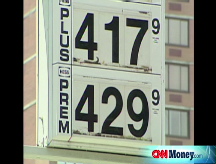Oil hits $140 for the first time
Intraday and settlement records set on $5 surge as comments from OPEC, Libyan officials raise supply and price concerns.
NEW YORK (CNNMoney.com) -- Oil reached $140 a barrel for the first time ever Thursday following reports that Libya may cut production and an OPEC official said crude could hit $170 a barrel this summer.
Meanwhile, the dollar's decline against the euro added further upward price pressure.
"I think this is just a combination of all those" factors, said Mark Waggoner, president of Excel Futures in California.
Light, sweet crude for August delivery ended the trading day at a record settlement of $139.64 a barrel, up $5.09, on the New York Mercantile Exchange - the third-largest single-day jump on a dollar basis in trading history. The previous settlement mark of $138.54 was set June 6, when oil prices jumped a record of $10.75 a barrel.
Just before the close, oil spiked to an intraday record of $140.39 a barrel. The previous trading high of $139.89 was set June 16.
"This is volatility-based momentum," said Stephen Schork, publisher of energy trading newsletter The Schork Report.
A lot of bears, investors who bet that the price of oil is going to go down, started buying oil to cover their short sales because they are afraid oil will shoot up overnight, said Schork.
Short selling occurs when investors sell a borrowed security, in this case an oil contract, hoping that the price will go down so they can replace it with another one at a cheaper price. Short sellers can lose big if the price goes up.
Oil could easily fall as low as $132 again, said Waggoner. But he believes prices will eventually break through $140 to top off at around $150-$155 a barrel.
Supply worries. Ongoing concerns over supply disruptions in Africa and the Middle East were the impetus for the surge.
The largest supply concern came out of Libya, which threatened to reduce production.
According to a report by the Bloomberg news service, Shokri Ghanem, chairman of Libya's National Oil Corporation, said reductions may be made because the market is oversupplied.
Other reasons given by Ghanem: A response to sanctions against Iran, also a member of the Organization of Petroleum Exporting Countries, and a bill being discussed in Congress that could allow lawsuits against OPEC countries.
"Even if they pulled 300,000 barrels a day off the market, that would have an impact," said Tom Orr, head of research at Weeden & Co.
Speaking to France 24 television Thursday, OPEC president Chakib Khelil said oil prices could rise to between $150 and $170 a barrel during the summer. He added that he didn't think oil would hit $200 a barrel.
Earlier in the week, Chevron Corp. (CVX, Fortune 500) said workers belonging to Pengassan, a white collar union in Nigeria, had gone on strike. Strike concerns persisted Thursday, threatening to shutter oil producing facilities.
Tension between Israel and Iran was also a concern. On Wednesday, Iran's speaker of the parliament, Ali Larijani, warned that a military strike by western nations or Israel would "cost them heavily."
Fed rate hold. Some oil investors may also have been a little disappointed over the Fed's decision Wednesday to keep a key interbank lending rate at 2%, according to Phil Flynn, senior market analyst with Alaron Trading in Chicago.
On Thursday morning, the Commerce Department revised the country's gross domestic product upward to a 1% annual rate. But the GDP, along with the Fed's statement, may not have painted as positive a picture as many oil investors had hoped.
"You put the two together and it wasn't enough to... wow anybody," said Flynn.
Dollar doldrums. The dollar slipped against the euro and other major currencies on Thursday morning, a day after the Fed's announcement.
Oil is traded in dollars, so any strengthening or weakening in U.S. currency has been influencing oil prices over the past several months.
The Fed's decision was largely expected. But Flynn said some in the market hoped the Fed would have decided to raise rates, or at least have used stronger language suggesting future rate increases, which would bolster the dollar.
"It was kind of a wishy-washy statement on inflation," said Flynn.
Oil prices settled down more than $2 in the previous session, but crude has been trading in a large range recently, rising or falling about $4 a barrel daily. ![]()



